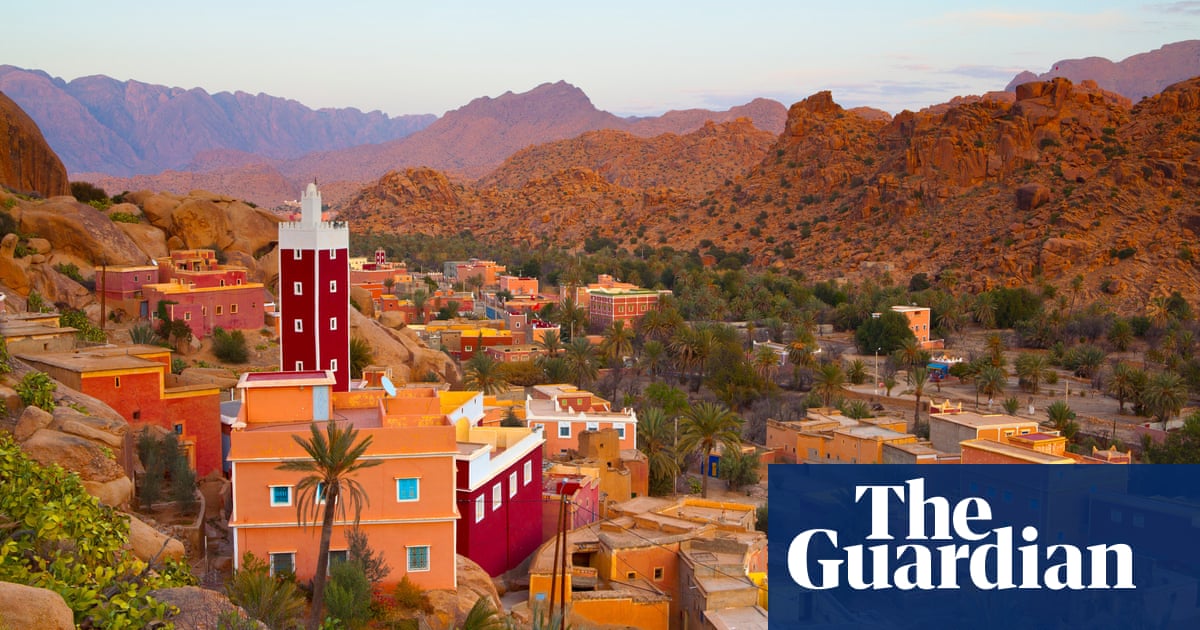The calm city ofKhenifrais well worth a detour from the main tourist routes of Morocco. It enjoys a lovely location on the banks of the Oum Er-Rbia river and is surrounded by the Atlas mountains, which keep the air fresh, clean and invigorating for strolling around. It’s also just a short bus ride away from the Khenifra national park. I spent two days hiking there enjoying beautiful lakeside walks breathing in the fragrances of the Atlas cedar trees. Don’t miss the source of the Oum Er-Rbia and its gentle waterfall, tumbling down the reddish rocks.Joe
Taghazout, a 30-minute drive north of Agadir, is already on the map as a surf destination, but as the sun goes down the town’s skatepark is the place to head. Built in just a few weeks on public ground by 100 volunteers from around the globe, it’s become a community hub, as well as a place for visitors to gather and witness some epic tricks against the stunning ocean backdrop. Skateboards and safety gear are available to rent, and lessons are available. Because the scene feels more inclusive than at UK parks, you may well be tempted.Gemma
TheMedina Stories food tour(about £35 a head) in Marrakech is just fabulous. The guide, Rachid, is a trove of historical and culinary expertise, taking you to more than a dozen off-the-beaten-track stalls, bakeries, cafes and restaurants to snack on all manner of local delicacies, from homemade yoghurt and breads to cow spleen sandwiches and snails. You end up drinking mint tea overlooking the bustle of Jemaa el-Fnaa. It’s a brilliant entry to the medina for disoriented tourists. We even took our toddler and he absolutely loved it, except the snails.Matt Bishop
On the road between the legendary fort of Aït Benhaddou and the desert paradise of Merzouga is a little-known town calledAgdz, a peaceful haven with a huge ancient casbah. In the north of the town, surrounded by palm and pomegranate trees, the casbah is a relic of the caravan trading route to Timbuktu, and is a maze of mud-brick houses and fortifications. Having the opportunity to walk freely through such a vast historical site without any interruption or fee was a unique experience.Danny
The steep, craggy mountains of the Ameln valley in the Anti-Atlas tower over the manyAmazighvillages dotted along the valley floor. Ancient houses and minarets cling to the mountainside. Occasionally, you may hear sounds from behind a courtyard wall, but mostly it’s a quiet and enchanting place where you could spend weeks following the narrow paths between the villages. There are a handful of guesthouses –Bio Beldiin Ait Omgas has a simple, spacious two-bedroom apartment (€55 a night, B&B). The restaurant downstairs serves delicious dishes using food from the garden.Craig
The unpretentious and magnificently namedTaha the Grandsonrestaurant on the promenade of Agadir was a real find among the more tourist-oriented beachfront places to eat. It is run by Iraqi Taha as a work of devotion to his late grandfather. We found friendly and helpful service, delicious Middle Eastern food (the Iraqi lentil soup was a delicious starter) and an expert lesson in how to make a proper cup of mint tea (it’s all in the pouring). On top of the wonderful food, it proved excellent value.Matt Lunt
Sign up toThe Traveller
Get travel inspiration, featured trips and local tips for your next break, as well as the latest deals from Guardian Holidays
after newsletter promotion
Last November, my best friend and I attended the thirdZamane festivalin the small oasis town ofM’Hamid El Ghizlane, on the edge of the Sahara. From Marrakech we drove through the High Atlas and Anti-Atlas mountains, stopping at our leisure to let the natural beauty of the surroundings and its people sink into our souls. We stayed in a beautiful and affordable casbah in the city of Ouarzazate. In the early evening of the first day of the festival we arrived and immersed ourselves in the music, the colours and the energy. A remarkable three-day celebration of nomadic life with the soundtrack of desert blues (a fusion of blues and rock from the Sahara). The performance of the headliner,Bombino, was a fitting climax to the whole unforgettable experience.Humberto Pena
Rabat was the city break I didn’t know I needed. Often overlooked by tourists in favour of Marrakech or Fez, it offers a Moroccan experience that feels refreshingly unhurried. Wandering its medina, I was charmed by the warm greetings of locals, happy to help or simply let me browse their spices, leather and perfumes without the pressure I found elsewhere. Just steps away, the restless Atlantic Ocean provided a peaceful escape, with breezy walks along the shore clearing my mind. The city also has a sleek, modern tram system, making exploration effortless (and even offering free wifi). Visit before the secret gets out.Zoe
We travelled around Morocco last year and were pleasantly surprised by how easy it was to get around by bus and train. We also booked accommodation as we went – hostels and riads. Some of the beautiful riads were tucked away down tiny alleyways; it seemed unbelievable that we’d ever find them. A great place wasAtlantic Hostelin Essaouira (£15 per person). It was friendly, simple and clean, and had the most wonderful rooftop terrace. For vegetarian food, we’d recommendVeggie Pausein Fez.Melanie
Taking a seven- and eight-year-old to Marrakech for half-term was, some said, madness. However, we wanted to show our granddaughters life beyond Spain. They delighted us by fearlessly embracing colourful, multi-scented alleyways and bazaars, waterfalls where free-roaming monkeys yanked their pigtails, beautifulMajorelle gardens, calming Berber villages in the Atlas foothills and sunset desert camels. TheBohemian Junglewas our riad base: a magical, fantastic, music-filled paradise with Moroccan ivy reaching from roof garden to pool. The icing on the cake, a dressing-up room!Diana Rees
